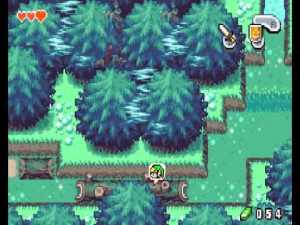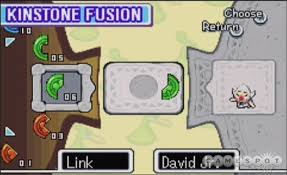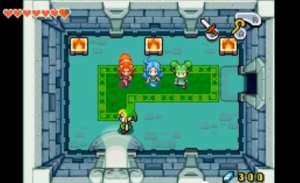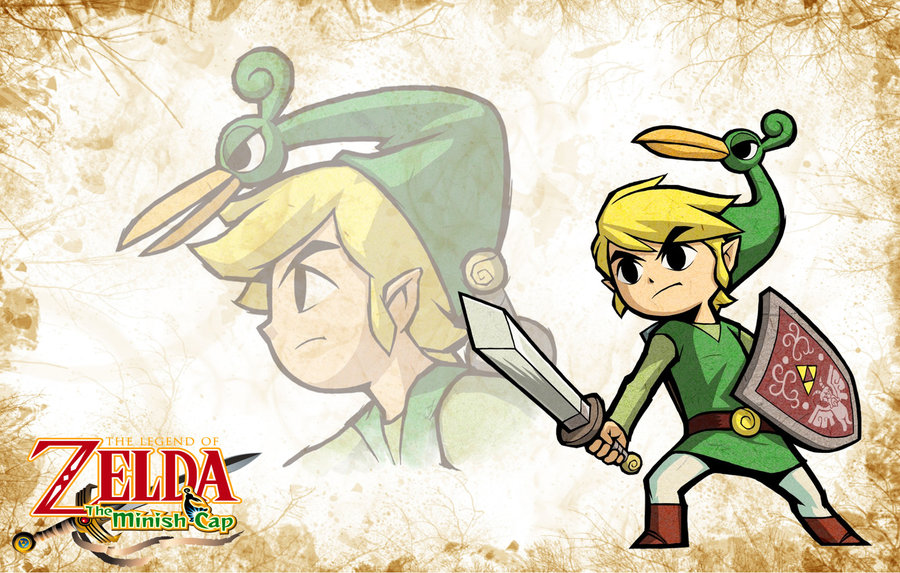I’ve owned The Minish Cap for some time now. Even started a playthrough once or twice, but for some reason, I could just never keep myself interested. A couple of weeks ago though, I decided to pick it up and get through it. After finally getting past the second section, which is where I stalled out, I found a game that was extremely appealing to me and which I couldn’t get enough of.
The Set-up:
You are Link and you have been tasked with accompanying Princess Zelda to Hyrule Castle during an annual festival. As you’re going there anyway, you must also deliver a sword to the castle to be used in a ceremony. I wonder why Hyrule doesn’t allow last names…
The Story:
Everything to do with the story is fairly typical Zelda fare. After delivering the sword, the recipient (by virtue of a contest) takes it, and immediately reveals himself as the villain of the game, Vaati. He turns Princess Zelda to stone, fights off the soldiers, and then leaves in search of a great power that he expected to find at the castle. At the center of his scheme is a sword crafted by the Picori, a tiny race of beings that saved Hyrule in the past but seem to have since vanished. As it turns out, only Children can see them, so Link is recruited to take the now broken Picori Blade to the Minish Woods in hopes of finding the Picori and having them reforge the blade, which should free Princess Zelda from her stone curse.
The wrinkle arrives when Link meets Ezlo, a strange creature that resembles a bird and a hat. Ezlo reveals that Link will have to shrink to see the Picori and has the power to help him do so. Ezlo then settles on Link’s head and serves a role similar to Navi from Ocarina of Time.
As with prior Zelda titles, reforging the sword is only the start of the adventure. As Link, you’ll battle through multiple dungeons and areas as you uncover Vaati’s history and Princess Zelda’s role in his plans. I admired the fact that Nintendo didn’t pull Vaati at the last minute and introduce Ganon as the primary antagonist. Vaati is a very good villain for the game and it was nice to not have a puppet type situation.

As a side note here, it’s worth mentioning that this game falls into the Four Swords subset of Zelda titles. Vaati is present in both of the other games and both make the Link splitting mechanic touched upon in Minish Cap a central aspect. I’ve never delved too deeply into those games, but felt that little factoid deserved a spot here.
The Gameplay:
Again, very standard for a Legend of Zelda game. You gradually find items that will open up new areas for exploration. There’s a town where you will buy supplies, characters you’ll interact with, sidequests, etc… There are, however, two aspects that set Minish Cap apart in my mind from other entries.
The first is the shrinking ability. Initially, I just assumed that you’d see larger versions of your surroundings, but it is actually implemented in a very clever manner. Shrinking is limited to certain areas, which allowed the designers to create puzzles around getting to new areas while tiny. It has a very Metroid type feel to it. You can see areas where you need to journey while tiny, but don’t yet have the equipment to get there. I loved this particular aspect of the game and felt it was brilliantly implemented.

The second mechanic is the entirely optional Kinstone sidequests. Kinstones are stone halves you’ll find throughout hyrule in the same ways you find rupees, hearts, etc… The key to these is that the other inhabitants of Hyrule also have Kinstone pieces. If you press “L” while standing next to one and they have a piece, they’ll offer to fuse with you. If you have the corresponding half, you can complete the Kinstone with them, leading to something happening in Hyrule (there are only about nine types of Kinstones, so you should generally have more than enough to fuse). Some will make chests appear, some spawn golden enemies that are harder to defeat, but worth about 100 rupees upon being defeated, while some open up doors or make other random events occur. While this is mostly optional (there is one point in the game where you must find Kinstones to proceed, but it’s confined to one area and is a relatively short sequence), it was very intriguing for me. I would revisit the citizens of Hyrule numerous times to see if they would fuse with me. This is the kind of non-forced sidequest that I love to see in Zelda games. Fun without a requirement.

Aside from those two conventions, as I said at the beginning of this section, this is mostly a standard Zelda game. There are the normal puzzles you encounter, some new items that are quite neat (I especially loved the leaping and gliding ability of the Roc’s Cape), and the ability to clone yourself as you add Elementals to the Picori Blade (finally making it the Four Sword, as seen in the Four Swords games). This ability doesn’t show up too often, making it a neat idea that doesn’t get tired. The puzzles using the clones (who all mimic your movements) are sometimes devious, but not hard enough to be frustrating.
Conclusions:
I think what I just said is the key to this game. There is no frustration to be had. Nearly all Zelda games have that one puzzle or that one temple that seems to slow the game down to a crawl, but that’s not the case here. Everything about this game is very measured, which makes for an incredibly enjoyable experience. It could be argued that the game is a bit short, but for a handheld title, I think it’s length is adequate. The best compliment I can give this game is that it feels like a spiritual sequel to A Link to the Past. No, it doesn’t equal Link to the Past, but it stands alongside it well and the design constantly made me think back to the Super NES masterpiece. For those still seeking a Link to the Past fix, even after playing A Link Between Worlds, I feel that The Minish Cap is the game you should visit next.



Leave a reply to Gabriel Cancel reply